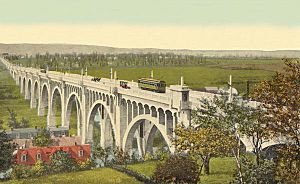Albertus L. Meyers Bridge facts for kids
Quick facts for kids Albertus L. Meyers Bridge |
|
|---|---|

Postcard (dated 1916) depicting Allentown's Eighth Street Bridge.
|
|
| Coordinates | 40°35′47″N 75°28′16″W / 40.5963°N 75.4712°W |
| Carries | Two lanes northbound and one lane southbound of 8th Street, from Union Street to Lehigh Street, and 2 sidewalks |
| Crosses | Little Lehigh Creek, Harrison Street and Martin Luther King, Jr. Drive |
| Locale | Allentown, Pennsylvania |
| Official name | Albertus L. Meyers Bridge |
| Named for | Albertus L. Meyers |
| Maintained by | City of Allentown |
| Characteristics | |
| Design | Reinforced concrete open-spandrel arch |
| Total length | 2,650 feet (810 m) |
| Width | 45 feet (13.72 m) (deck width) |
| Height | 138 feet (42 m) |
| Longest span | nine 120-foot (36.58 m) broad arches |
| History | |
| Opened | November 17, 1913 |
| Statistics | |
| Daily traffic | 14618 |
| Toll | Free |
| MPS | Highway Bridges Owned by the Commonwealth of Pennsylvania, Department of Transportation TR |
| NRHP reference No. | 88000870 |
| Added to NRHP | June 22, 1988 |
The Albertus L. Meyers Bridge is a famous bridge in Allentown, Pennsylvania. It is also known as the Eighth Street Bridge. This bridge is a great example of early large-scale concrete building.
When it opened on November 17, 1913, it was the longest and highest concrete bridge in the world. The bridge crosses the Little Lehigh Creek. It connects Allentown's city center with its South Side.
The Albertus L. Meyers Bridge has seventeen sections, called spans. It is even longer than the Tunkhannock Viaduct, which is another large bridge of the same type.
Contents
Building the Albertus L. Meyers Bridge
The Allentown Bridge Company was created in 1911. Their only goal was to build this important bridge. The engineering firm B.H. Davis designed the bridge. McArthur Brothers from New York City built it.
Building the bridge cost more than $500,000. This was a lot of money back then! Construction started on July 1, 1912, and finished on November 17, 1913. Workers used a huge amount of concrete and metal rods to make it strong.
The bridge stretches for 2,600 feet (about 792 meters) across the Little Lehigh Creek valley. It is about 38 feet (about 11.5 meters) wide. It has two lanes for cars and two sidewalks for people to walk on.
Tolls and Trolleys
When the bridge first opened, you had to pay a toll to cross it. This means it was a "toll bridge." For cars, the toll was five cents. The bridge stopped being a toll bridge in the 1950s.
The "Liberty Bell Line" also ran across the bridge. This was an electric streetcar service. It connected Allentown to other towns like Quakertown and Philadelphia. The streetcar service stopped running on September 6, 1951.
All rail operations on the bridge ended in 1953. This was when the company stopped all street trolley service. You can still see the concrete poles on the bridge today. These poles once held up the trolley wires.
Why the Bridge Was Renamed
The Eighth Street Bridge was officially renamed in 1974. It became the Albertus L. Meyers Bridge. The bridge was named after Albertus L. Meyers. He was a very famous conductor of the Allentown Band. He also played the cornet in the band of John Philip Sousa.
When he was a boy, Albertus L. Meyers played in the Allentown Band. This was at the opening ceremony of the very bridge that now carries his name.
The Albertus L. Meyers Bridge was added to the National Register of Historic Places on June 22, 1988. This means it is recognized as an important historical landmark in the United States.
Images for kids
-
Construction of Albertus L. Meyers Bridge in Allentown, 1912



